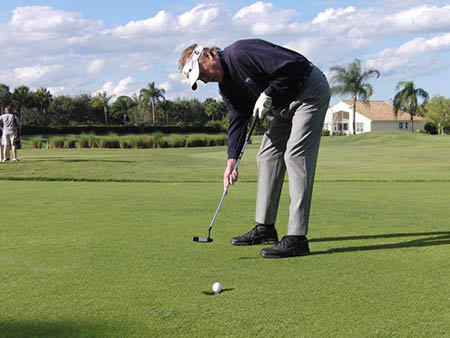Five Star Master Golfer

A Legacy Post by Keiser University College of Golf Senior Faculty and Director of Research Dr. T. J. Tomasi (1940-2023)
What would golf be like if you didn’t keep score? It might be really fun, especially while you are learning – plus, it’s much easier to “learn.” But for about 95% of golfers, the barometer of progress is “what did you shoot?” Psychologist BF Skinner’s research shows that when people are punished, all they really learn is how to avoid punishment. And for too many golfers, bad scores elicit the ultimate form of avoidance – quitting the game. Bad scores are a form of punishment, but the good news is that the ‘bad’ in bad shot is attenuated by simply removing the penalty, i.e., don’t keep score.
Paul Trevillion Putting
Case in Point: Paul Trevillion, an artist and avid amateur golfer reached a long par five in two mighty whacks. Left with a simple four-footer for his first ever eagle, he missed badly and became so affected by his failure to make three that he knocked his ball into the woods and vowed never to play another round of golf. Stewing over the inequity of a 300-yard drive down the middle counting the same as a four-foot putt, he resolved to skip the long game and became the best putter in the world. To do this, he invented one of the most unusual styles ever seen where he bent doubled over like a snooker player, grasping the shaft near the club’s neck. But it worked, and in money-putting matches, he was never beaten.

My impersonation of Paul Trevillion.
How to Master Golf
To avoid Trevillion’s fate while you are learning, perhaps the following golf protocol is in order:
- Divide your effort into four areas [pillars]; your swing, equipment, your golf brain, and your golf body.
- Find an instructor that will help you map out your acquisition of resources for each level of accomplishment in each area; i.e., she/he will outline what you need and show you how to get it.
- Develop a system of rewards which are allocated after you complete each level – as in the martial arts where they recognize expertise by awarding colored belts (white, green, blue, black, etc.).
Let’s say your instructor divides the swing acquisition pillar into grip, stance, ball position, aim/alignment, takeaway, setting the angle, the position at the top, slotting the club, release, and balance – each one is learned separately and rewarded by point system. You need a certain number of points before you progress to the next level – you must have 200 grip points (then you are a Master of the Grip) before you move to aim. You have four bag tags – one for each pillar, and when you complete all the levels in any pillar, you are awarded a “golden golfer star.” If there are 10 levels to the fitness pillar, you need 10 Silver Golfer Stars to get your Golden Golfer, a big bright star at the top of the bag tag that can be seen by all. Mastery in each pillar (four Golden Golfers) confers on you a fifth bag tag with the silhouette of a golden golfer and the words Five Star Master Golfer. This is just one of many templates that could be used to implement the gamification of golf.
Learn more!
Want more tips? If you want to take your game to the next level, contact our team at Keiser University’s College of Golf & Sport Management today. With our dedication and experience, we can elevate your game to new heights together. Give us a call today at 888-355-4465.














